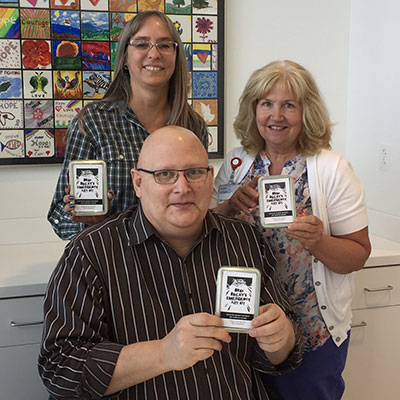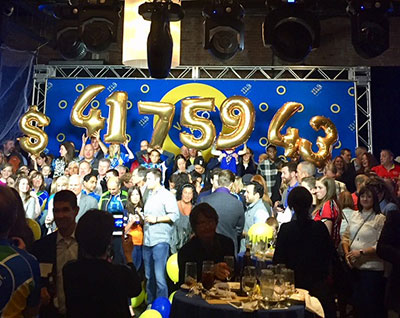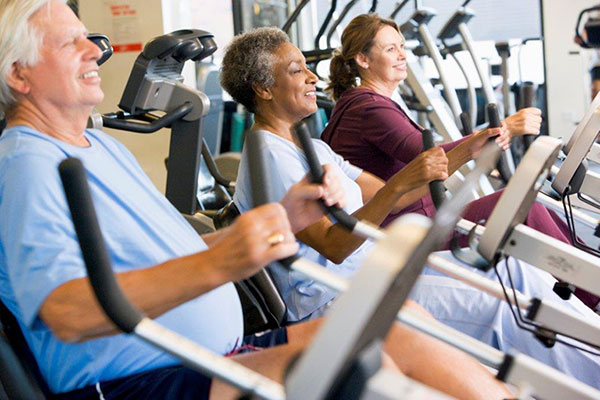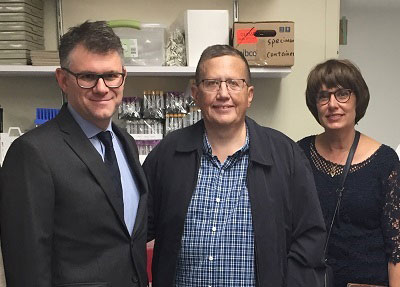“Emergency” art kits give cancer patients a dose of inspiration

Brad Bailey never left his house without four essential items: wallet, keys, phone – and art supplies.
That’s why, last winter, when he woke up in the hospital without anything to draw on or with, he felt completely lost.
“I thought, this is unacceptable. Totally wrong,” says the professional artist, who spent his career at Kaman’s Art Shoppes, a company (the largest of its kind in America) that trains and hires the artists who paint faces and draw caricatures at amusement parks.
Mr. Bailey was at Cleveland Clinic’s Taussig Cancer Center for treatment of his sarcoma. Previously, complications had caused him to lose a leg, and he now uses a wheelchair. His spirit undeterred, Mr. Bailey saw an opportunity to focus his art on more “romantic” subjects: he taught himself watercolors and began spending warm afternoons out and about his hometown in Oberlin, Ohio, painting street scenes and landscapes.
“I’m a punk,” Mr. Bailey says good-naturedly. “I specialized in caricature; my art made fun of people. But now, I’ve found the beauty in beauty, if you know what I mean.”
Hatching a plan
As he looked around his hospital room that winter day, longing for his supplies, Mr. Bailey’s eyes fell on a small, greeting-card size tin that was being used to store medical supplies. “And it hit me that this tin could be used for something else,” he says.
By the time he was discharged, Mr. Bailey had a plan.
With help from members of his church, he and his wife, Tammy, raised enough money to buy 200 tins and set about creating art kits for hospitalized patients.
“I wanted to help other people,” he says. “Art anchors me. I remember who I am and I don’t get lost in the hospital bed when I have art.”
The gift of inspiration
Inside each limited-edition Brad Bailey Emergency Art kit, you’ll find 50 pieces of card stock, three assorted travel-size colored pencils, a pencil sharpener, one ultra-fine Sharpie pen, one mechanical pencil, and over 50 sketching ideas.
Mr. Bailey says that the small size is intentional. “You can put it in your glove box so it’s there when you need it, like a spare tire.”
The kits were lovingly assembled by members of Mr. Bailey’s church, who got together on a Saturday afternoon to help their friend realize his vision.
“Nineteen people worked for two hours to put the kits together,” Mr. Bailey says. “There was an 8-year-old and an 80-year-old. There was such a great vibe!”
Lisa Shea, Art Therapist at the Taussig Cancer Center, is helping to distribute the 200 kits to patients at Cleveland Clinic main campus and The Gathering Place.
The very first patient to receive a kit was Amir Williams, a 37-year-old Cleveland native who was diagnosed with Stage IV colon cancer in April 2017.
Mr. Williams is an artist as well, although he never pursued it professionally.
“My wife didn’t believe me a few years ago when I told her I could draw,” Mr. Williams says. “She said, ‘Why hadn’t you told me before?’”
He is now working on a portrait of her.
“Art is a really inspirational thing,” Mr. Williams says, adding that he was very grateful to receive the kit. “It was a good outlet for me, an opportunity to create some beauty.”
Like Mr. Bailey, Mr. Williams believes in paying it forward. A civic activist, he appreciates that the cancer has given him a platform to raise awareness and spread education about the preventable disease.
“This is something that crosses political divides,” he says.
“I see it as a blessing, this opportunity to show other people what they can get through. We’re all going through something. Attitude is 90 percent of the journey.”
Adds Mr. Bailey: “People start conversations with me from a place of pity. But I don’t want to focus on the negative. I turn to them and say, ‘I’d like to give you a gift.’” He mimes handing someone an art kit. “And then I ask, ‘What did you create today?’”
Brad Bailey's meditative matras:
- Seek inspiration
- Foster kindness
- Slow down
Follow the hashtag #seekinspiration to see examples of the art inspired by Mr. Bailey’s kits.
VeloSano 4 Raises Record Amount

It’s official: VeloSano 4 raised more than $4.17 million to support cancer research at Cleveland Clinic. The amount was revealed with a huge balloon drop to an excited crowd of more than 600 at the annual VeloSano Bash: Revealing the Cash presented by The Lerner Foundation on Nov. 9. Emceed by the voice of the Cleveland Indians, Tom Hamilton, the Bash celebrated the accomplishments of all who participated in the annual cycling fundraising event.
VeloSano 4 took place July 21-23 in Cleveland and more than 3,200 individuals participated as riders, virtual riders and volunteers from 28 states and the District of Columbia, as well as Germany and Italy, to raise funds for cancer research. Nearly 26,000 donations were received from more than 22,000 donors from all 50 states, D.C., Puerto Rico, the Virgin Islands and 36 countries. One hundred percent of funds raised benefits cancer research at Cleveland Clinic.
“VeloSano brings doctors, patients, families and the community together with a common goal of beating cancer,” said Brian J. Bolwell, MD, FACP, former chair of Cleveland Clinic’s Taussig Cancer Institute. “Funds raised through VeloSano further cancer research and bring sophisticated options to our patients. In its first three years, VeloSano has funded 68 cancer research projects at Cleveland Clinic with immeasurable patient impact.”
The annual event now has raised a total of more than $12.4 million. In its first three years, VeloSano awarded Cleveland Clinic cancer physicians, scientists and researchers more than $8 million to provide additional resources and help bridge the funding gap.
Two types of awards are made through VeloSano. Pilot Awards use a competitive application and peer-review selection process to provide seed funding for cancer research projects with a high likelihood of attracting future outside grant support. Impact Awards are distributed by the VeloSano Medical Chairman to meet critical needs and strategic priorities of Cleveland Clinic’s cancer program such as equipment, advanced technology or laboratory expenses. Learn more about these projects and advancements in the VeloSano 2017 Annual Report.
Registration for VeloSano 5, scheduled for July 20-22, 2018, opens Monday, Dec. 4, and includes a special offer: Anyone who registers before Jan. 1 to ride 25 miles or more will receive a $25 discount on the registration fee.
Struggling to manage your Type 2 diabetes? Try this exercise

Doctors have long touted the benefits of aerobic exercise for Type 2 diabetes patients. Exercise elevates heart rate and improves the function of beta cells, which store and release insulin. Patients with Type 2 diabetes have developed a resistance to insulin, and therefore require more of it to keep their blood sugar under control.
New research from Cleveland Clinic suggests a unique kind of exercise, called functional high-intensity training (F-HIT), may specifically benefit people with Type 2 diabetes.
Avid gym-goers may know that this exercise trend, popularized by CrossFit, involves short bursts of high-intensity activity and blends weight training, resistance and cardio.
John Kirwan, PhD, a researcher at Cleveland Clinic Lerner Research Institute’s Department of Pathobiology, led a study that tested F-HIT’s effectiveness at lessening insulin resistance.
Twelve adults with Type 2 diabetes who did not routinely exercise participated in a six-week trial where they trained three days a week.
Researchers administered an oral glucose tolerance test before and after the trial to measure changes in beta cell function. The data revealed a significant improvement in participants’ insulin regulation after the study.
“We discovered that functional exercises such as squats, lunges and pull-ups, performed fast and at high intensity for as little as 10 to 20 minutes per day, three days a week, improved how the pancreas regulates insulin in patients with Type 2 diabetes,” Dr. Kirwan says.
This research is especially critical because there is no cure for Type 2 diabetes, which affects millions worldwide and is growing in prevalence. The Center for Disease Control and Prevention reports that 1 in 3 Americans will develop the disease over a lifetime.
Clinicians recommend that patients carefully monitor weight and blood sugar levels to manage their care. They also recommend lifestyle changes such as healthier eating habits and exercise.
While larger studies are needed to confirm Dr. Kirwan’s results, it appears that F-HIT may offer a low-cost, accessible way for these individuals to keep their disease and symptoms in check.
HITting the gym
Ryan Sidak, fitness specialist at Cleveland Clinic’s Walker Center, leads group and individual F-HIT classes. He argues that the workout has a benefit that most others lack—efficiency.
Mr. Sidak says that short, high-intensity exercises help the body more quickly burn glucose, our primary energy source. Once available glucose is used up, our body begins to burn glycogen, stored energy reserves. This can improve and stabilize blood glucose levels even before weight loss is achieved.
But that’s not the only benefit, Mr. Sidak says.
“F-HIT can be tailored to someone who is just starting out, or someone who is really advanced because the high intensity is going to be completely different to me than to you.”
Mr. Sidak’s clients are encouraged to find their own baseline, their own level of comfort, and then apply varied levels of intensity. This can be really empowering.
It also makes them more accountable, as Dr. Kirwan points out in his study. This sustainability is critical to reap any long-term benefits.
Dr. Kirwan’s lab is dually focused on understanding the biological mechanisms that lead to insulin dysfunction in patients with Type 2 diabetes and developing lifestyle strategies to counter the negative effects.
“Until we find a cure,” Dr. Kirwan says, “we have to ask: what can patients do today to improve their quality of life?”
While F-HIT can be an effective management tool for weight control and Type 2 diabetes, patients—especially those with known or suspected cardiovascular disease—should consult their doctor before beginning any high-intensity exercise programs.
Couple’s Gift Supports a New Approach to Organ Transplants

It was the summer of 2013 and Ron Shortridge was desperately seeking a diagnosis. He and his wife, Mary, crossed the country, visiting hospitals and specialists in Nebraska, Kansas and Arizona – even a holistic center in Minnesota – but no one could give them an answer.
Ron’s symptoms included extreme fatigue, abdominal pain and cognitive impairment, and he was always cold. By October, he was too sick to work or drive. Soon, he didn’t have the strength to walk and was bedridden. “Mary and I both thought I was dying,” Ron says.
Mary wasn’t giving up, though. A friend’s brother who is a physician offered to look through the thick medical files she had compiled. He concluded that there was a problem with Ron’s liver and recommended the Digestive Disease & Surgery Institute at Cleveland Clinic. Ron and Mary met with William Carey, MD, MACG, senior hepatologist in Cleveland Clinic’s Department of Gastroenterology, in late December. Ron says that within 15 minutes, Dr. Carey diagnosed him with alpha-1 antitrypsin deficiency, a rare, potentially fatal genetic disorder.
A Rare Genetic Abnormality
Alpha-1 antitrypsin is a protein made within liver cells that is normally expelled into the bloodstream. Alpha-1 antitrypsin deficiency is due to the liver’s inability to secrete the protein, which congeals within the liver cell. The excess, nonsecreted protein affects the liver, and low levels of alpha-1 in the bloodstream affect the lungs. While the resulting liver inflammation usually isn’t debilitating, occasionally, the damage is progressive, leading to scarring and complications of cirrhosis, which can include serious problems of bleeding and mental confusion.
Researchers believe that alpha-1 is undiagnosed in many individuals because not everyone with the genetic abnormality develops symptoms. Alpha-1 is diagnosed with a simple blood test. Currently, there is no cure for the disease.
By the time his disease was diagnosed, Ron’s liver was barely functioning, so Dr. Carey immediately began discussing liver transplantation. Testing showed that Ron was a good candidate for the lifesaving surgery, and he returned home to wait. In February 2014, he came to Cleveland Clinic for additional testing but was admitted to the hospital because he was so ill. He and Mary realized that if he did not receive a liver soon, he would die.
A Desperate Need for Organs
According to the American Liver Foundation, more than 17,000 people are awaiting liver transplants, and the list grows annually. Each year, more than 7,000 liver transplants occur in the U.S. while more than 1,500 people die waiting to receive a new liver.
Because he was so ill, Ron was a priority patient on the national transplant waiting list. His kidneys already had shut down, and he was on daily dialysis. Ron says he’ll never forget what happened one day in early March 2014. “My wife was next to me, holding my hand, when her phone rang,” he says. “All she kept saying was, ‘Praise God!’ She said it several times. It didn’t take long for me to figure out they’d found a match for me.”
Transplant surgeons Masato Fujiki, MD and Cristiano Quintini, MD, Director of Liver Transplantation at Cleveland Clinic, began the eight-hour operation at 3:30 a.m. on March 8 – a day Ron now calls his “re-birthday.”
He is emotional when speaking about the circumstances that led to his surgery. “My faith is the biggest part of my life. I believe God’s timing is perfect. But for my life to be saved, it means that somebody lost their life. The decisions their family had to make may have been difficult. It’s through their generosity that I was given an opportunity.”
A Better Way to Preserve Organs
Ron spent a month in the hospital recovering from surgery, regaining strength and adjusting to life as a transplant recipient. Dr. Quintini, who provided his follow-up care, began telling Ron about his research into ex vivo organ perfusion, a revolutionary technology that is changing the way donor organs are preserved.
Dr. Quintini and his team performed numerous experiments that led them to build a perfusion machine, a portable ICU that preserves organs better than standard methods, which haven’t changed in 40 years. It also has the potential to revive organs that are less than perfect, making previously unusable organs available for transplant.
It took Dr. Quintini and his team four years to progress from their original idea of maintaining a living organ to performing a successful human transplant employing their new approach. To date, 15 patients who otherwise had little hope for successful outcomes have received liver transplants; the organs all were preserved by perfusion.
“In research and development, this is considered an amazingly short journey,” says Dr. Quintini. “It was made possible by the passion and commitment of those involved and of philanthropic supporters who believed in our research.”
Funding the Most Powerful Gift
Ron and Mary’s strong belief in Dr. Quintini’s work led them to make a gift supporting his research and become dedicated advocates of organ donation and the ex vivo organ perfusion technique. “This has to be one of the top medical philanthropic projects you could support,” Ron says. “It’s not one that could possibly save lives when a cure is developed years from now – it can save lives right now.”
Dr. Quintini agrees. “With the right resources, we could bring this technology to patients around the world in as little as two years,” he says. “We know that this technology works. Our vision is to create an organ repair center for all organs and tissues – liver, heart, lung, kidney, and even amputated limbs. Our ultimate goal is to create a place where we revive injured organs that could give our patients one of the most powerful gifts of all, the gift of life.”
How You Can Help
You, too, can help fund Dr. Quintini’s research and make this technology available to patients who desperately need transplants. Please contact Jen Kealy at 216.444.4490 for more information, or make a gift here.

